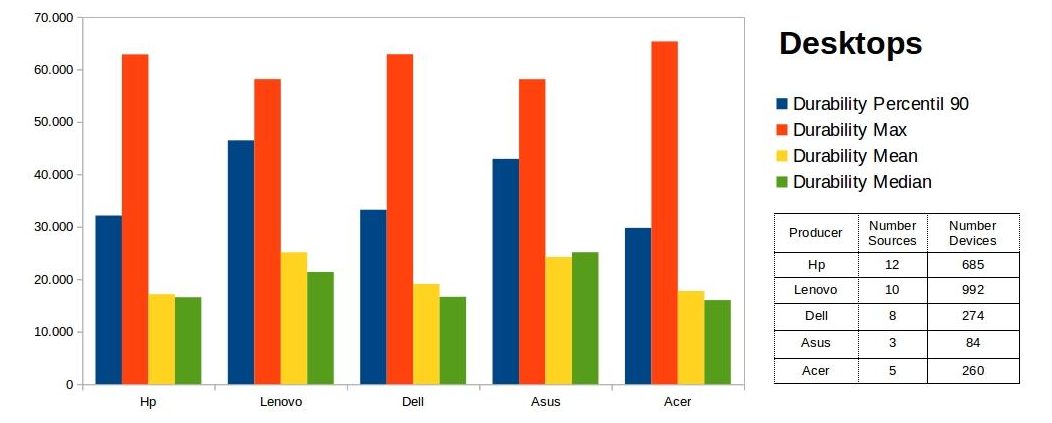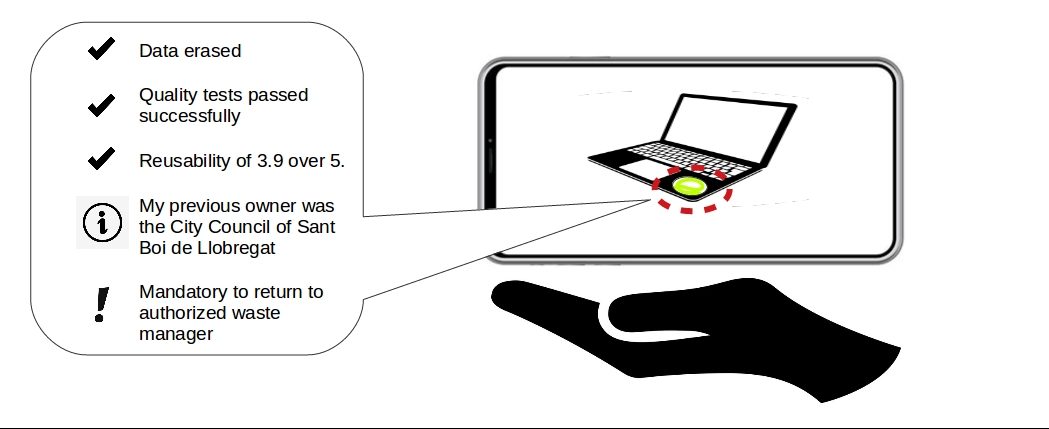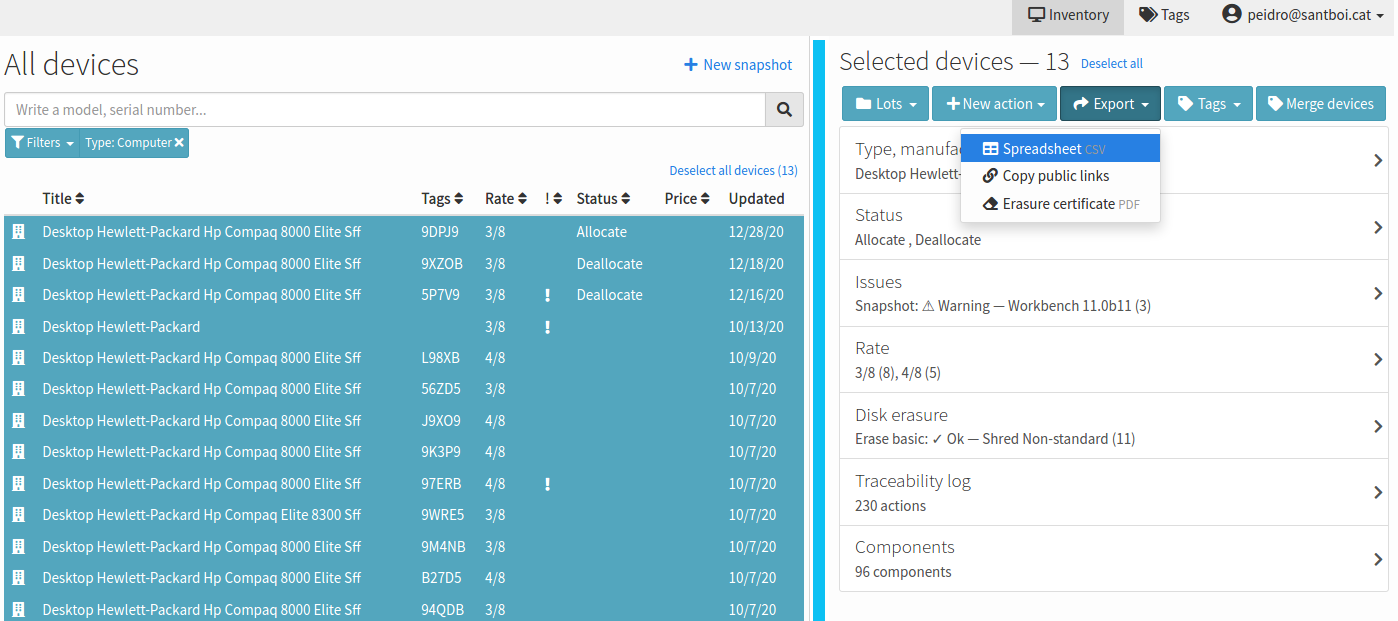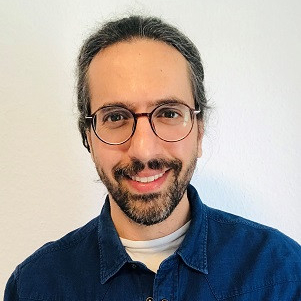“The next step is to replicate this Proof of Concept with other companies in the municipality, both product owners who dispose of devices for reuse and with refurbishing companies that collect, refurbish and distribute the devices to final users,” says David Franquesa in our interview, which is part of an ongoing “DLT4EU Interview Series”.
In this interview we speak about the teamwork of Natalia Moreno, Carles Peidró García and David Franquesa in their project that addresses the collaborative reuse of digital devices to reduce premature recycling and foster circular consumption in the City of Sant Boi de Llobregat – representing one of eight Virtual Field Labs in the DLT4EU accelerator programme.
DLT4EU stimulates cutting-edge distributed ledger technologies (DLTs) for public and social good by connecting the expertise of leading entrepreneurs and developers with real-world challenges and beneficiaries.
DLT4EU is led by a consortium comprised of Metabolic, Digital Catapult and Ideas for Change, with direct support and advice of the European Commission’s Joint Research Center.
Natalia Moreno is an EU Projects Officer who supports the management of local projects funded by EU Competitive Programmes and the European Regional Development Fund. Her role within this DLT4EU Virtual Field Lab is to facilitate the implementation of the pilot in the City of Sant Boi de Llobregat.
David Franquesa is director at eReuse.org, where he helps public administrations and regions to transition to collaborative and circular consumption of electronics. His role in this DLT4EU Virtual Field Lab is to create, connect and improve networks to increase reuse and recycling in the City of Sant Boi de Llobregat, as well as to ensure that there exists an Open Source platform and skills to support these reuse networks.
Carles Peidró García is a Planning and Evaluation Officer at the Sant Boi City Council where he assists the organisation in designing new planning tools and evaluation services. Furthermore, he covers needs regarding citizenship participation, communication, data analysis and product accountability. His role within this Virtual Field Lab of the DLT4EU programme is to facilitate the implementation of the pilot in the City of Sant Boi de Llobregat.
Sebastian Klemm: Which deep economic reforms do we need to tackle, in order to arrive at regenerative & intragenerationally just societies that manage to live within planetary boundaries?
Natalia Moreno: Historically, development has been synonymous with economic growth, which is equivalent to produce without limits. We are now coming to realise that the planet can no longer resist the impact of this production and that this growth has worsened existing social inequalities. If we want to reduce inequalities and leave a better world to new generations, we need to foster circular and blue economies that promote global sustainability.
David Franquesa: With more mobile devices than people on earth and powerful companies keen for us to keep purchasing, the successful implementation of the 3Rs – Reduce, Reuse, Recycle – for electronic devices becomes vitally important.
Today, most laptops, desktops and mobiles are prematurely recycled when they become obsolete or are written off by companies and public administrations. When we recycle a device that could be reused, we lose the use value of the computer and continue the model of linear consumption that is so damaging to the planet, as well as making devices exclusive because not all citizens have the economic resources to always buy new products.
Limiting premature recycling and promoting reuse is not the solution to our problem of unsustainability, but it is the way forward. The real reforms are to reduce the obsolescence of devices and make them cradle-to-cradle. But this is still not possible with electronic devices, so the least we can do is to make the most of all the ones we have produced.
Carles Peidró García: With regard to public sector measures, we should only carry out and support projects that provide social added value and are based on green values. This means that only projects that canprove to contribute to social equity and minimise environmental impacts are considered.

Sebastian Klemm: To tackle the obsolescence you mentioned before: What are the current limitations of effectiveness of the EU legislation on ecodesign – which claims to “further enhance the reparability and recyclability of appliances” as well as “ensuring the availability of spare parts – making key parts more easily replaceable – and access to repair and maintenance information for professional repairers”?
Through which measures and by whom can these possible legislative limitations be overcome to further support projects like yours in their municipal implementation?
David Franquesa: According to a Eurobarometer survey, however, 77% of EU citizens would rather repair their appliances than replace them. According to 79% of respondents, manufacturers should be required by law to make it easier to repair digital devices or replace their individual parts. EU Commissioners want to grant consumers a right to repair in the future, be it through the extension of warranties, guarantees for replacement parts or better access to information on repair and maintenance. There have already been initial successes. From 2021, for example, television manufacturers will have to keep power supply units and other important components in stock for seven years.
For other devices such as laptops and mobile phones, however, there are no Europe-wide regulations yet. France is now moving ahead with new regulations of this kind by introducing a “repair index” for washing machines, electric lawn mowers, televisions, PCs, tablets and smartphones as of 1 January 2021. This Indice de réparabilité will allow buyers to see how easily and inexpensively the appliance can be repaired.
What we propose for a municipal implementation, even at citizen level, is to trace the real durability that the devices have had throughout their life cycle. The aim is to create a durability index to complement it with reparability and other obligations to reduce obsolescence. Would you buy a second-hand car without knowing the kilometres it has run? – I don’t. Is it possible to know the durability of the devices, like how many hours it was powered on? – Yes, this is possible, almost 99% of hard drives collect this data. At eReuse we collect such anonymous data to create this ranking of durability. Take a look at HP desktops for example. We have around 700 hundred HP desktops in the traceability system, and we know that the average durability of HP desktops is 17 thousand hours. But we need more data to bring these rates closer to reality.

Sebastian Klemm: Why do you participate in the DLT4EU programme?
Natalia Moreno: The Sant Boi City Council is committed to promote circular economy and to become a city lab where innovative projects can be tested. DLT4EU was the perfect match!
David Franquesa: We fitted in 100% with the challenge of the municipality of Sant Boi de Llobregat and we liked the format in which the participants work side by side with a real project very much. We see that it is a step forward in the acceleration where you better validate your minimum viable product.
Carles Peidró García: There are not many options to get in touch with these new and complex technologies from a public sectore perspective. The DLT4EU programme is a way to realise their potential to provide answers to the challenges of cities. Once you are part of it, you get knowledge about the topic and have an idea of who is part of it. Certainly, new opportunities will arise as these technologies will be introduced in our organisation.
Sebastian Klemm: What particular qualities of the DLT4EU accelerator distinguish this programme in your opinion?
David Franquesa: The quality of the contents, the mentors and the supervision of the projects distinguish this programme. Some of this content is a real masterclass to me, such as the presentations on DLT governance, narrative and communication, open source and innovative disruption. I would also like to mention the very valuable feedback documents we received from the mentors after each pitch.
Natalia Moreno: For me, the programme stands out because of the complexity and support given throughout the six-month programme on a vast range of topics by a panel of experts. There were three Bootcamps where you could learn from the rest of the participants and panelists as well as work with your team on how to best address the challenge and market the Proof of Concept.
Carles Peidró García: I would distinguish three elements: 1) The continuous “physical” support from the three organisations coordinating the accelerator, as we have a singular reference that stands close to us. 2) A great variety of tips, masterclasses and workshops that feed every stage and dimension of the design and implementation process of the projects. 3) The continuous feedback from mentors, coordination members and participants from other organisations on a wide range of topics, from the business model to how to create a presentation with impact.
Sebastian Klemm: What are the societal and environmental challenges that your particular project “Collaborative reuse of digital devices to reduce premature recycling and foster circular consumption in the City of Sant Boi de Llobregat” addresses?
Natalia Moreno: Our project contributes to achieve several Sustainable Development Goals (SGDs), such as promoting sustainable consumption and production patterns, climate action, quality education and reduction of inequalities.
David Franquesa: When we avoid premature recycling of a device and extend its lifetime by 5000 hours, we generate great savings for consumers and the planet. The benefits are many, such as environmental savings, green jobs (refurbishers), local resilience (refurbishment) or lower cost of access to devices for consumers as the profit margin is limited and the supply of second-hand devices is increased.
Carles Peidró García: We try to conceive a “4 in 1”: 1) How to minimise device consumption so that we contribute indirectly to reducing the ecological footprint by using less natural resources and stimulate a preference among citizens for second hand devices instead of new ones. 2) How to boost a circular economy ecosystem that can benefit local economic activities. 3) How to create new circular economy activities for social inclusion, like those for people with impairments or mental conditions. 4) How to ensure equal opportunities in online education with the help of refurbished free devices.
Sebastian Klemm: The DLT4EU programme focuses the application of DLTs to the areas of “Circular Economy” and “Digital Citizenship”. How do you apply distributed ledger technologies in your particular project to help solve these challenges for the public good?
Natalia Moreno: David will explain the technical side of it better. Personally, I feel that DLT will help to provide us with secure data on the reuse of digital devices which will allow us to evaluate the impact on vulnerable families, on reducing the carbon footprint as well as on the benefits that a circular economy project can bring to the city and its citizens.
David Franquesa: Our challenge is to account for the circular economy impact of reuse and that means to attest that a device has been reused and its device lifetime extended for a certain number of hours, and that the device at the end of its usage lifetime has been properly recycled by authorised waste management companies. The difficulty is to trace these devices with a standard protocol and accounting for the lifetime extension over multiple owners and possessors without affecting privacy and ensuring data reliability. The DLT has emerged in response to these use cases.
Carles Peidró García: The key concept is trust. As a supplier, you must have the guarantee that your devices are received by those you choose, be they social institutions, individuals with material needs or whoever is recognised in the proper “contracts” subscribed by both parties. As a beneficiary, you must have quality guarantee for the refurbishment carried out and the details of the treatment of the devices. As refurbishers, you must have visibility and quality certification for the work done. As public administrations and citizens, you must have access to comprensible metrics in order to know the global impact of the reuse system, based on reliable data about the final use of the devices.
Sebastian Klemm: Throughout the DLT4EU programme and along the bootcamps with mentoring therein: What have you been developing so far?
David Franquesa: Devices discarded by the City of Sant Boi de Llobregat are either reused or disposed of. The city administration uses an open-source ERP system to perform the data erasure, quality testing and inventory of their discarded devices. They also use the same system to monitor and account for the impact generated by the reuse and final recycling of these devices.

As a result of the first phase, i.e. the processing for reuse, every device has its own product passport, an url with a reuse potential score, data erasure certificates, the hours of usage and a list of quality tests carried out. The municipality shares these quality certificates with final users such as schools that have students in vulnerable situations and do not have any devices at home. Final users trust these quality certificates because they are generated automatically and can not be manipulated manually.

During the second phase, the reuse of devices, schools are responsible for delivering the devices to the final users. When devices are received by final users the city administration changes its status to assigned in the ERP system.

If a user expresses their consent to usage data collection, a desktop application installed on the device reports the functionality status of the device and the hours the device has been powered on. Based on the collective data of final users, the city administration may generate reports at any time to account for the social impact of closing the digital divide and the circular economy impact such as extended durability.

Generated reports are timestamped using the eReuse.org DLT to ensure their audability, allowing an external auditor to verify the authenticity of the data. When the final user returns the device to the city administration or brings it to a recycling point, there is a web app to notify the process to the ERP system.

Sebastian Klemm: Mostly, systemic requirements for certification require transparency and accessibility of the standard-setting organisation’s working methods as well as objectivity and impartiality of the standard setter towards the licensee or certificate holder.
If the quality certificates are “automatically generated and cannot be manually manipulated”, as you described, why is there still a need for cumbersome third-party audit mechanisms? Is it a possibility to design the governance mechanism for your particular quality certification as an accessible digital public good to render third party auditing unnecessary, indeed?
David Franquesa: Thanks to the eReuse ERP system and the DLT, a single source of accurate information and an unalterable record are available. This brings greater transparency and auditability to all operations and transactions carried out by the members of the ecosystem. The technology allows the implementation of an agile auditing system based on the records generated by the different information sources. In the case of the Proof of Concept, one source is the Sant Boi City Council, which shares its ERP Reports with the auditor, or even on its website as it is information that it wants to make public. The auditor or a citizen only has to verify if the timestamp of the report exists in the DLT. This process is done with a single click. The advantage of writing the timestamp into the DLT and not the data is that in this way the confidential and personal information of the sources and participants is preserved.
Carles Peidró García: That would be desirable: The more autonomous and distributed the system governance may be, the better it will be.
Sebastian Klemm: In our preceding interview about DLT4EU, Alice MacNeil says: “One of my favourite experiences was with the Venture Teams as part of a Storytelling Masterclass by Hayley Bagnall of Altus Impact, as part of the Barcelona Bootcamp in November. It was rewarding to see how the teams shifted their narrative about what they were doing, from a technology-first perspective to a more social, impact-driven focus. Not only was it fun, but we learned a lot about how to tell the story of your project and the power of storytelling. DLT can be quite niche, and this kind of approach allows us to tell a better story to a wider audience, to connect DLT4EU to a more public and democratic space.”
What have been inspiring moments to you personally during both your work together as a team & the overall DLT4EU programme so far?
Natalia Moreno: The feedback given by mentors was very inspiring. It helped us to pitch an engaging presentation of the project. David did great in the last Bootcamp. We have worked together as a team from the very beginning, from shaping the Proof of Concept and adapting it to a small pilot that can be scalable when more actors get involved in the future, to creating a visual presentation.
Carles Peidró García: For me it has been the Masterclasses, like the one on the Pentagrowth methodology, that make you act in a more open-minded, integrated and complex way. Finally, the advice and feedback from mentors at the end of each presentation has been inspiring, as they focus on issues that one hasn’t taken enough into account or as they shake assumptions that may have been not as sophisticated as one thought previously.
David Franquesa: We have received advice from all the mentors which has helped us to better define, design and communicate the project. In particular, I recognise that I have greatly improved my ability to synthesise the project so that it is more easily communicated and understood.

Sebastian Klemm: Following your participation and insights so far: What evidence of positive impact and benefits of the DLT4EU accelerator do you see already?
David Franquesa: Since the project has started, the electronic reuse circuit of Sant Boi de Llobregat has 30 PCs and 30 monitors available for reuse, which will be distributed to families at the beginning of next year. When we manage to extend the life of a computer, the direct benefits for consumers – the health of the planet and its precious and increasingly scarce raw materials – are of great value.
Say we extend the life of a computer by 5,000 hours, at the environmental and resource level we thereby save 190 kilograms of water, 1000 kilograms of minerals and 316 kilograms of CO2. At the economic level, we create a local economy for refurbishment companies. Moreover, at the social level, we have counted savings of up to 500 € per device for public administrations to close the digital divide. Although, in our opinion, it is the indirect benefits that have the greatest impact in the medium and long term.
For us, it is key that the data to generate a data driven circular economy is collected, verifiable and that the impact of the circular economy is created. Having the eReuse ERP System and a DLT has been a major challenge of technological innovation and will have a remarkable impact. This network of distributed registers will help public administrations, refurbishers, recyclers, manufacturers and other organisations to securely share and control all the data in the system and to encourage the reuse of electronics and recycling at the end of its life.
Furthermore, there are no costs for development or maintenance of an overall infrastructure due to the absence of a central system.
Carles Peidró García: DLT already resonates in a more friendly and understable way within the municipality. We just begin to sense the potential of DLT development for our work. We realise that we can afford ourselves and citizens second-hand devices as operative and useful as new ones. We can have a real circular economy ecosystem emerge as we have some of the key actors, as well as other potential new ones. All these are neither objective facts or evidence-based statements, but they are qualitative elements that may show an emerging awareness shared by a wide range of departments related to this topic, from IT services to education and social services.
Sebastian Klemm: One of neighboring DLT4EU Virtual Field Labs is concerned with “Enabling Peer-to-Peer Energy Solutions“. Could you already explore opportunities for knowledge transfer in regard to circular solutions for solar waste manufacturing and end-of-life modules?
David Franquesa: There is great potential for application, but currently we are only focusing on digital devices. The reason is that in order to have a reliable and verifiable process, it is necessary that the process of creating the device’s passport is done by means of software that runs on the device and extracts the characteristics, the functional state and all its components. When we have this software ready for the solar systems we will be able to include it. We must advance little by little but in a firm way making the traceability system safe and not fraudulent.
Sebastian Klemm: How will you sustain your engagement and project development beyond the final presentations at the European Commission in March 2021?
David Franquesa: The next step is to replicate this Proof of Concept with other companies in the municipality, both product owners who dispose of devices for reuse and with refurbishing companies that collect, refurbish and distribute the devices to final users.
In order to achieve the participation and engagement of all the actors in the circuit – product owner, refurbishers, final users – it is essential that the social and circular impacts generated through the reuse and final recycling can be certified. It is also necessary to replicate the circuits in other cities and to interconnect them in order to manage the challenge of balancing supply and demand, so devices from Sant Boi de Llobregat can be derived to Barcelona and vice versa.
At the citizen level, the engagement is to promote the eReuse product passport standard for refurbished devices. The aim is to facilitate reuse and account for the real durability of digital devices. Thanks to the durability index we are generating, consumers will have a reference that they can use when they decide to buy a new device.
Currently, our eReuse open-data durability meter count is tracing the real durability of over 10,000 devices, but we need more to make it realistic. If you have devices at home or in the office, please share their durability. We will also introduce you to creating a product passport, deleting your data and certificate its functional status to facilitate its reuse.
Natalia Moreno: Carles Peidró García and I are planning to communicate the results and short-term impact of the project internally and externally with local stakeholders and citizens, which we hope can enable and encourage other actors to get involved in the circuit of donating, repairing and reusing digital devices!
Carles Peidró García: Natalia Moreno’s reference to communicating results may be critical in measuring internal support for the continuity of the project. Ideally, a “second” pilot project should be implemented, involving both an external provider, such as a company, and other refurbishers, particularly a local social foundation with expertise inrefurbishing training and workshops.
Communication will be extremely important in all cases. Therefore a new interface application and web repository with visualisation of live data would be extremely well received by us – featuring data on the entrance and exit of devices from the system, as well as impact results from the use of the refurbished devices.

Further readings:






